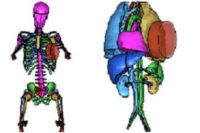NHTSA unveils new "10-year-old child" crash test dummy

 The nation’s automotive safety agency has a new crash test dummy that will be used to evaluate the growing number of child safety seats and boosters made for children weighing more than 65 pounds. The National Highway Traffic Safety Administration’s (NHTSA) “10-year-old child” dummy is the latest addition to the agency’s family of test dummies and is the best tool currently available for measuring the risk of injury to a child using a higher-weight child restraint system in the event of a vehicle crash.
The nation’s automotive safety agency has a new crash test dummy that will be used to evaluate the growing number of child safety seats and boosters made for children weighing more than 65 pounds. The National Highway Traffic Safety Administration’s (NHTSA) “10-year-old child” dummy is the latest addition to the agency’s family of test dummies and is the best tool currently available for measuring the risk of injury to a child using a higher-weight child restraint system in the event of a vehicle crash.
“It’s good news that manufacturers are making more car seats and boosters than ever before designed to keep older and heavier children safer on our roadways,” said U.S. Transportation Secretary Ray LaHood. “As the marketplace evolves to accommodate changing consumer needs, it’s important that safety regulators also have the best tools possible for evaluating how well these products work. The new test dummy breaks new ground for the Department’s crash test program and is a significant step forward for evaluating child seat performance.”
The 10-year-old child test dummy was developed in concert with new safety seat requirements updated to keep pace with the latest scientific research and child restraint system technologies. It will provide never-before-available information capturing the risk of injuries using head and knee excursions, as well as chest acceleration. The final rule issued by NHTSA today amends the current federal child safety seat standard to include car seats and boosters specified for children weighing more than 65 pounds and up to 80 pounds. The expanded standard will evaluate how well the higher-weight restraint systems manage crash energy and if the seat’s structure stays intact by incorporating the use of the dummy for the first time ever in compliance tests. Manufacturers will have two years to certify their higher-weight car seats and boosters to meet the new requirements.
“Our new dummy is an excellent addition to NHTSA’s extensive child seat compliance testing program and will enable the agency to gather the best data yet on the performance of higher-weight child seats,” said David Strickland, NHTSA Administrator. “Even as we begin to reap the benefits of this new tool, NHTSA is already looking down the road and has research under way to further improve the dummy.”
The NHTSA issued more stringent child safety seat recommendations last year encouraging parents and caregivers to keep children in a car seat with a harness for as long as possible, up to the height and weight specifications of the seat. The agency’s updated child seat guidance also recommends that children ride in a booster seat until they are big enough to fit in a seat belt properly, which is typically when the child is somewhere between 8-12 years old and about 4 feet 9 inches tall.
Looking for a reprint of this article?
From high-res PDFs to custom plaques, order your copy today!






